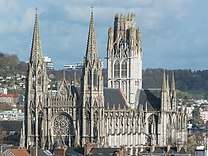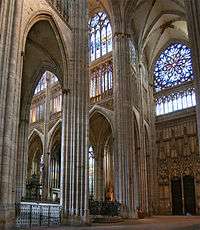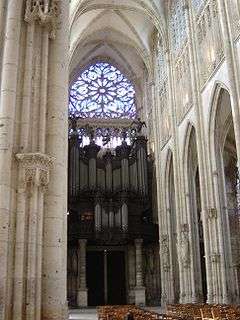Church of St. Ouen, Rouen
The Church of Saint-Ouen Abbey, (French: Abbatiale Saint-Ouen) is a large Gothic Roman Catholic church and former Benedictine monastic church in Rouen. It is named for Audoin (French: Ouen, English: Owen), 7th-century bishop of Rouen in modern Normandy, France.[9] The church's name is sometimes anglicized as St Owen's.[10][11] Built on a similar scale to nearby Rouen Cathedral, the abbey is famous for both its architecture and its large, unaltered Cavaillé-Coll organ, which was described by Charles-Marie Widor as "a Michelangelo of an organ". With the cathedral and the Church of Saint-Maclou, Saint-Ouen is one of the principal French Gothic monuments of the city.


(view as an 360° interactive panorama)
| Saint-Ouen Abbey Church | |
|---|---|
| Saint-Owen Abbey Church[1][2][3] | |
Abbatiale Saint-Ouen | |
 The Abbey Church as seen from the Great Clock | |
 Saint-Ouen Abbey Church Location of Saint-Ouen | |
| 49°26′33″N 1°05′59″E | |
| Location | City Hall Square, Rouen, Normandy |
| Country | France |
| Denomination | Roman Catholic |
| Website | rouen |
| History | |
| Status | Abbey Church |
| Founded | 750[4] |
| Dedication | Saint-Ouen |
| Dedicated | 17 October 1126 |
| Relics held | Saint-Ouen |
| Architecture | |
| Functional status | Defunct |
| Heritage designation | Classée Monument Historique |
| Designated | 1840[5] |
| Architectural type | church |
| Style | Gothic, Flamboyant |
| Groundbreaking | 1318 |
| Completed | 1537 |
| Specifications | |
| Number of towers | 3 |
| Bells | 3 bells : "Saint-Ouen", 4 tons (1701); "Marie", 3 tons (1651); "Julie Marcelle", 2135kg (1887)[6] |
| Administration | |
| Archdiocese | Rouen |
| Clergy | |
| Archbishop | Dominique Lebrun |
| Laity | |
| Organist/Director of music | Marie-Andrée Morisset-Balier[7] |
| Organist(s) | Jean-Baptiste Monnot[8] |
Building details | |

| |
| General information | |
| Location | Rouen, Normandy |
| Height | |
| Antenna spire | 82m |
The Abbey

The church was originally built as the abbey church of Saint-Ouen for the Benedictine Order, beginning in 1318 and interrupted by the Hundred Years' War and sacked and badly damaged during the Harelle. It was completed in the 15th century in the Flamboyant style.
The foundation of Saint-Ouen Abbey has been variously credited, among others, to Chlothar I and to Clotilde, royal saint and wife of Clovis I, but evidence is scanty. It was dedicated at first to Saint Peter when the body of Audoin, Archbishop of Rouen (d. 678), was buried there; the name of St Peter and St Ouen became common and finally St Ouen only.
The history of the abbey, on record from the 1000, is unremarkable; a list of abbots is in Gallia Christiana XI, 140.
In 1660 the monastery was united to the Congregation of Saint Maur, and when suppressed, in 1794, the community numbered twenty-four. The abbey building itself was vacated by the time of the French Revolution and was subsequently occupied by the Town Hall of Rouen.[12]
Architecture
The church is 137 m in length under 33 m high vaults. The central crossing is surmounted by an unusual lantern-style tower similar to that at Ely Cathedral in England. The tower was completed in the Flamboyant style.
The well-preserved stained glass of the nave dates to the 15th and 16th centuries, and features jewel tones among panels of clear and frosted white glass. These materials allow more light to filter into the nave, creating a brighter interior than is typical of Gothic churches. Despite the use of Flamboyant tracery in the aisles, triforium, and clerestory, the nave maintains a conservative appearance through the use of compound piers, trumpet bases, and capitals which helps maintain harmony throughout the edifice.
The west façade was never completed during the Middle Ages. The present structure was constructed between 1846 and 1851 in a Neo-Gothic style that bears little resemblance to the original Late Gothic designs.
- Architectural Details
.jpg)
.jpg)
.jpg)
.jpg)
._(2788175980).jpg)
.jpg)
.jpg)
.jpg)
.jpg)
.jpg)

Organ

The church contains a large four-manual pipe organ built in 1890 by Aristide Cavaillé-Coll. This instrument is considered to be one of the most important organs in France, and is notable for its unusually powerful 32' Contre Bombarde. The organ stands unaltered and thus is one of the few of the master's works to speak with its original voice.
|
|
|
|
| ||||||||||||||||||||||||||||||||||||||||||||||||||||||||||||||||||||||||||||||||||||||||||||||||||||||||||||||||||||||||||||||||||||||||||||
- Couplers: Tirasse G.O., Tirasse Pos., Tirasse Réc., Appel G.O., Pos./G.O., Réc./G.O., Bomb./G.O., Pos./Réc., Bomb./Réc., Oct. gr. G.O., Oct. gr. Réc./G.O., Oct. gr. Réc., Oct. aiguë Réc., Anches Péd., Anches G.O., Anches Pos., Anches Réc., Anches Bomb., Trémolo Réc., Expression Réc.
Notes
- "Reference to the name on Oxford Reference website".
- "Example of the use of this spelling". Archived from the original on 2016-05-09. Retrieved 2016-04-26.
- "Example of the use of this spelling".
- "French article about the church and its bells".
- "Official website, edited by the French Ministry of Culture, referencing listed buildings".
- "French article about the church and its bells".
- "Article on the nomination of new assistant organist (in French)". Archived from the original on 2016-04-29. Retrieved 2016-04-22.
- "Article on the nomination of new assistant organist (in French)". Archived from the original on 2016-04-29. Retrieved 2016-04-22.
- "Ouen (Audoin, Owen), St , bishop of Rouen", The Oxford Dictionary of the Middle Ages, Oxford University Press, 2010-01-01, doi:10.1093/acref/9780198662624.001.0001/acref-9780198662624-e-4391, ISBN 978-0-19-866262-4, retrieved 2020-06-28
- Walcott, Mackenzie Edward C. (1860). The Ministers and Abbey Ruins of the United Kingdom: Their History, Architecture, Monuments, and Traditions; with Notices of the Larger Parish Churches and Collegiate Chapels. London: E. Stanford. p. 127.
- "Our Patron Saint | St. Owen Catholic Church | Bloomfield Hills, Michigan". web.archive.org. 2016-05-09. Retrieved 2020-06-28.
- "Abbey of Saint-Ouen", Catholic Encyclopedia, Volume 13, retrieved 2020-06-28
Bibliography
- Davis, Michael T. and Linda Elaine Neagley. "Mechanics and Meaning in the Plan Designs of Saint-Urbain, Troyes and Saint-Ouen, Rouen," Gesta 39 (2000): 161-182. https://www.jstor.org/stable/767144
External links
| Wikimedia Commons has media related to Église Saint-Ouen de Rouen. |